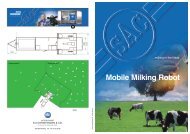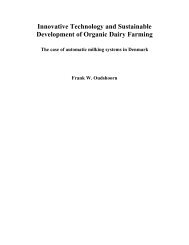Validation of Calibration Equations Developed ... - Automatic Milking
Validation of Calibration Equations Developed ... - Automatic Milking
Validation of Calibration Equations Developed ... - Automatic Milking
Create successful ePaper yourself
Turn your PDF publications into a flip-book with our unique Google optimized e-Paper software.
According to the results reported by Hansson (2011) the early season calibration equation<br />
was expected to give the most precise predictions <strong>of</strong> pasture yield and the late season<br />
calibration equation the least precise, see summary <strong>of</strong> results in Appendix 2. If results <strong>of</strong><br />
coefficient <strong>of</strong> determination (r 2 ), confidence intervals and width <strong>of</strong> prediction intervals in<br />
percentage <strong>of</strong> the predicted yield (Appendix 2) are considered, the equation without<br />
seasonal effects is expected to be more precise than the late season equation. If the<br />
prediction intervals for sward heights <strong>of</strong> approximately 180mm or less are considered<br />
(Figure 4.1) are the two equations expected to achieve similar prediction precision. Only one<br />
<strong>of</strong> the sward height observations in the validation dataset was above 180mm and similar<br />
precision can therefore be expected.<br />
Prediction intervals - all equations<br />
Yield, kg DM/ha<br />
1000 2000 3000 4000 5000 6000<br />
Early season<br />
Late season<br />
Season omitted<br />
140 160 180 200 220 240 260<br />
Height, mm<br />
Figure 4.1 - <strong>Calibration</strong> equations with height before harvest as predictor plotted with 95% prediction<br />
intervals (Hansson 2011)<br />
11




